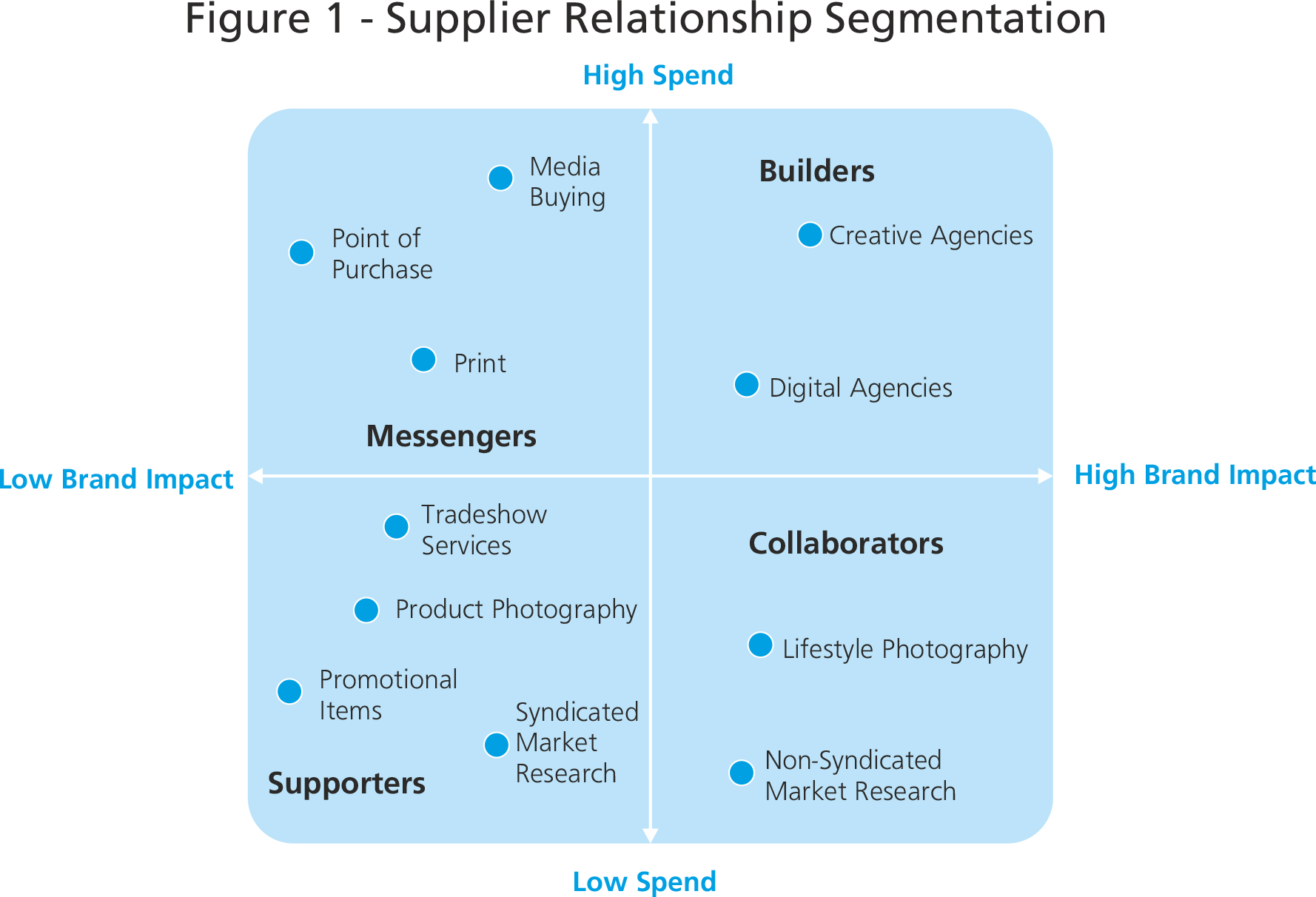Marketing - Agile Supplier Relationship
In the Apparel, Footwear & Accessories (AFA) marketing world, the greater your ability to move, the faster you can succeed. Procurement professionals that manage marketing categories need to have supplier relationships that are agile enough to react to rapidly evolving brand strategies. An agile supplier relationship diminishes the downtime between the reaction and the implementation phase of an evolving brand strategy. Procurement professionals are in charge of these supplier relationships and can indirectly help influence a brand's marketing success through effective management.
To add to the complexity of having an agile agency base, procurement professionals are challenged to develop and maintain these relationships across a diverse spectrum of products and services, including creative content, printed materials, and POP fixtures. As such, procurement must look to develop a framework for dealing with suppliers according to their spend level and overall impact on the brand messaging. This framework should allow multi-channel firms a systematic means of engaging with partners that remain flexible as a brand grows and develops to meet consumer trends.
Supplier Relationship Quadrant
Partnering with marketing agencies in the AFA industry should not only be agile and flexible, but should also promote cost reduction when possible. A well-managed supplier base is essential for reaching this goal, and it allows marketing organizations to capitalize on emerging trends and other fashion developments. The segmentation of supplier relationships by “Spend Levels” and the “Level of Brand Impact” is key to defining the right strategy for each supplier engagement which translates into how the procurement department will source and manage the category, on both a contract and performance basis.

As evidenced in Figure 1 “Supplier Relationship Segmentation,” (a proven Relationship Segmentation mechanism), agencies are placed on a quadrant based on their annual spend level and on the respective impact they have on the brand message. Brand impact can be measured as the complexity of the supplier relationship and the ultimate influence this supplier has on brand messaging.
Let's compare two popular forms of photography with regard to brand impact: product photography and lifestyle photography. Product photography is not often considered as a strategic procurement category since the deliverables are rather rigid in specifications, allowing for consistent output to be obtained from any number of suppliers. These suppliers add no additional value to the brand message. In contrast, lifestyle photographers offer incremental value to the brand message due to the fact that these images promote the tone the brand is looking to share with its customers.
Each procurement professional will need to work with the respective marketing stakeholder(s), for they ultimately determine where a procurement category sits on this continuum and, most importantly, what various sourcing and supplier management strategies to leverage.
Guidelines for managing suppliers in each of these quadrants are outlined below
Brand Builders
These agencies have a significant role in helping AFA firms collaborate on their brand's position in the marketplace. Agencies in this quadrant drive brand equity and help shape public perception of product and/or service offerings. Creative agencies are typically classified in this quadrant because they have the maximum influence on the brand image and perception. Procurement professionals should be highly sensitive to this relationship because these agencies are often an extension of the brand's creative energies.
Sourcing
While procuring services or materials from suppliers in this quadrant, procurement teams should spend a significant amount of time understanding the brand's placement in the market and strategic position in the marketplace in order to identify capable agencies. Often, such agencies bundle other services that fall in other parts of the segmentation, driving a price premium. Procurement should look to unbundle these services and use other sourcing techniques to procure from suppliers other than the Brand Builders. Such a deep level of partnership lends itself to incentive-based pricing structures. This type of compensation model directly ties the interest of the client to that of the agency, motivating the partner to go beyond standard service level agreements (SLAs). It is common for agencies to devote extra resources or put in extra hours when their success is so closely tied to that of the brand. This willingness to travel the extra mile is particularly important, given the short lead times and seasonality that dictate the activities of marketing departments within the AFA industry.
Agency Management
Close collaboration between agencies and internal marketing teams in this category is almost inevitable. However, these relationships need to remain properly structured to allow a clear distinction between agency contributions and those from employees. Effective delineation between internal responsibilities and agency deliverables begins with a well-defined statement of work (SOW). Through tightly controlled contract management and periodic performance evaluation, procurement can ensure that maximum value is being realized as a result of a core agency relationship. In dealing with suppliers from this quadrant, the establishment of recurring engagement points is highly encouraged. These can take the form of weekly status updates and quarterly performance reviews.
Brand Collaborators
AFA suppliers within this quadrant often partner with the Brand Builders to arrive at a final deliverable. For example, it is difficult for a creative agency to roll out a new advertising campaign without the support of a lifestyle photographer. Likewise, a targeted digital campaign is greatly enhanced by nonsyndicated market research and other consumer segmentation data.
Sourcing
The sourcing of this supply base is viewed from two lenses. If the work is brand campaignfocused (clear start-and end-campaign), there is an inter-agency relationship between the Brand Builder (e.g., digital agency) and the Brand Collaborator (i.e., lifestyle photographers). In this case, it is better to manage and source these relationships in a Tier-I-Tier-II manner in which the digital agency will be responsible for managing the Tier-II agencies, photographers and the associated costs. On the other hand, if the agency relationship is not inter-agency, procurement should look to adopt similar sourcing as the Brand Builders.
Agency Management
The inherent challenge for procurement is to ensure that these inter-agency relationships are properly managed without wasting the time of internal resources. A clear process plan is an effective means of outlining expectations. This process plan helps to define what type of communication and collaboration is expected between the agencies and in which stage of the advertising lifecycle they are situated. For example, if a creative agency knows that it can access retouched digital images from a lifestyle photographer on a shared corporate repository, then it can plan its campaign development schedule accordingly.
Brand Messengers
Suppliers in this quadrant are especially important to AFA firms in the dissemination of the brand's image to the customer base. However, the overall impact these suppliers have on the brand image is fairly negligible, leading to commoditized services from the AFA firm's perspective. Deliverables in this category are often more commoditized in nature, and once specifications are clearly outlined, anyone from a preferred pool of suppliers should be capable of providing the desired product or service.
Sourcing
This segment represents an ideal opportunity for leveraging a competitive bid environment amongst a network of pre-qualified suppliers to drive savings and institutionalize best-in-class procurement processes. A transition to this type of supplier relationship management may entail a procurement process transformation. Rebate structures lend themselves to this type of supplier dynamic. It encourages the marketing organization to drive additional spend toward suppliers with competitive rebates, while encouraging agencies to take a long-term perspective regarding their involvement with a brand and its development.
Supplier Management
The standardization of specifications and supplier expectations greatly eases the burden of the procurement department. However, these suppliers should be evaluated periodically to help procurement maintain an up-to-date understanding of industry cost and performance drivers, as well as the impact these factors have on marketing expenses and response times.
Supporters
Supplier relationships in this quadrant are more transactional in nature and require limited relationship management. Once standardized rate cards are negotiated and implemented, annual or bi-annual reviews are suggested for the purpose of ongoing category management.
Sourcing
The procurement team should keep this supplier base in mind in order to offer value-added services beyond the materials they provide. Since the products and services provided in this segment are fairly commoditized, agencies look to differentiate themselves. Differentiation comes in the form of offering tools to enhance the ease of ordering or the ability to inventory customer-owned material. For instance, in the promotional items space, it is common for suppliers to have online portals for marketing teams to order/customize their promotional orders. Procurement should seek out these services so they can drive additional value to their organizations.
Supplier Management
From a management standpoint, procurement should look to have limited engagement with these firms. The relationships, as previously mentioned, may warrant annual or bi-annual reviews.
An important theme resonating throughout the marketing-supplier relationship segmentation is that organizations benefit greatly from aligning priorities with those agencies that are core to brand image and messaging. By putting in place procedures to effectively manage transactional supplier interactions, a majority of the marketing department's efforts can be focused on strategic partnerships. Additionally, effective management of suppliers in all quadrants can quickly translate into tangible cost reductions. Savings realized as a result of procurement initiatives can be funneled back into marketing campaigns and directed toward other strategic initiatives.
Case Study
GEP Auction platform helps multi-billion dollar organization in AFA industry
The Challenge
Print is a category that often falls in the upper left-hand section of the supplier relationship quadrant, as outlined in Figure 1. This was the case for a multi-billion dollar player in the AFA industry. The client's portfolio consisted of dozen distinct footwear brands, each of which had fostered their own supplier relationships for the print category. Primary deliverables for these brands included catalogs and brand books for direct distribution among customers and retailers, as well as large format graphics and other marketing collateral intended to promote sales and new product launches. Despite the existence of a centralized creative department, noncompliant spend amongst the brands plagued the organization.
Even with the creative department's centralized procurement function, print jobs that originated in this department were often given to preferred suppliers based on long-standing relationships without obtaining competitive proposals or benchmarks. These preferred suppliers were the long-time partners that would come through at the 13th hour to meet the brand's requests. However, a significant premium was built into the rates of the incumbent supply base in exchange for this flexibility.
The Solution
Print deliverables are easily standardized amongst a pre- qualified supplier base, positioning GEP Auction as an ideal procurement management solution. GEP first sought to identify the future preferred supplier base for inclusion in the tool by evaluating the incumbent and new suppliers via an in-depth RFP process. Suppliers were asked to quote an extensive market basket pricing worksheet and to provide printed samples for many of these items. Additionally, an RFP questionnaire captured information regarding general service, equipment, material distribution and technological capabilities. Through collaboration between GEP and the client's creative department, a handful of suppliers was shortlisted and the GEP Auction tool training commenced.
Process improvements were realized by working with the brands, the creative department, and the preferred suppliers to develop documents that clearly outlined which party was expected to undertake responsibilities, and when. This process began with a brand identifying a future print need and concluded with final material delivery by the supplier. GEP Auction allowed for the automation and standardization of many of these process stages by generating automated supplier bid notifications and creating a centralized platform for print instruction to be posted prior to a live auction. On the cost side, the results really spoke for themselves. Over the course of the past eight months, the client has saved an average of 35%, or about $1 million a year, on external print jobs.
Conclusion
In addition to the individual brand's adoption of centralized purchasing, the creative department quickly came to recognize the value that a clear process plan and online bidding platform could add. Gone are the days when faxed and e-mailed quotes are buried deep in old folders and archives files; this information now resides centrally on the GEP Auction platform and is easily accessible by multiple users. No longer must the department rely on one or two print partners for major projects; they now have a competitive pool of suppliers -- all of whom can meet the timelines and quality standards of the brands. The creative department is now processing more print jobs, while dedicating less overall resources as a result of these improvements.
The GEP Auction technology served as the framework for a larger procurement process redesign that is having a long- lasting positive impact on the organization, from both a cost and a resource perspective. This technology fits neatly into the mold of many organizations in the AFA industry, which are driven by short lead times, but must still ensure that rates are as competitive as possible.

